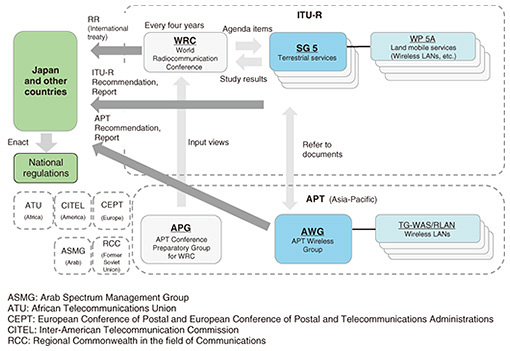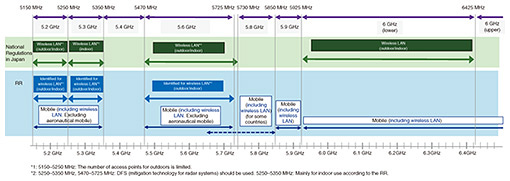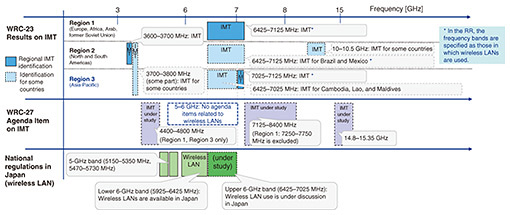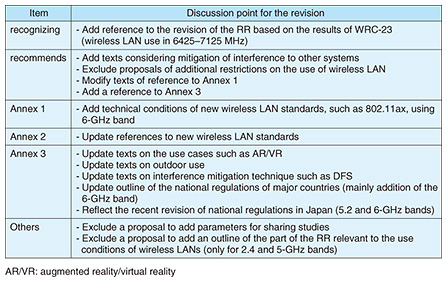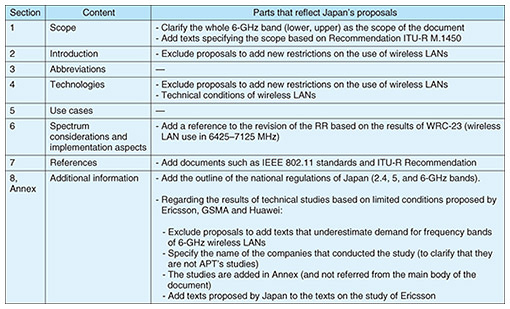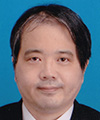 |
|||||||||||||
|
|
|||||||||||||
|
Global Standardization Activities Vol. 23, No. 5, pp. 49–55, May 2025. https://doi.org/10.53829/ntr202505gls Discussions on the Use Conditions of Wireless LANs in ITU-R and APTAbstractThe amount of data communication using wireless local area networks (LANs) in smartphones, personal computers, audio/visual equipment, household appliances, and other devices has been increasing rapidly, and demand for expansion of the frequency bands available for wireless LANs to achieve higher speeds and higher quality is growing. In response to this situation, the International Telecommunication Union - Radiocommunication Sector (ITU-R), an international standardization organization, and the Asia-Pacific Telecommunity (APT), which consists of countries in the Asia-Pacific region, are discussing the regulatory aspects such as the use conditions of wireless LANs. Because these discussions are important to NTT”Ēs business dealing with wireless LANs, NTT continuously participates in them as the Japanese delegation in charge of wireless LANs at each meeting. This article describes the status of recent discussions on wireless LANs at ITU-R and APT and NTT”Ēs efforts. Keywords: wireless LAN, ITU-R, APT 1. Standardization and rules related to wireless LANsStandards and certification conditions for wireless local area networks (LANs) are set by the Institute of Electrical and Electronics Engineers (IEEE) and the Wi-Fi Alliance, respectively. The basic technical conditions and operational rules for wireless LANs are determined in the World Radiocommunication Conference (WRC) and the International Telecommunication Union - Radiocommunication Sector (ITU-R) for the entire world and in the Asia-Pacific Telecommunity (APT) for the Asia-Pacific region [1]. Since these use conditions and rules are reflected in national regulations of wireless LANs in various countries including Japan, carriers, equipment manufacturers, and users of wireless LANs involved in each country are strongly affected. 2. Organizations involved in discussions on the use conditions of wireless LANsAs shown in Fig. 1, multiple organizations interact with each other to determine the use conditions for wireless LANs. WRC of ITU meets every four years to revise the Radio Regulations (RR), which are equivalent to enforceable international treaties. As a recent revision of the RR for wireless LANs, at WRC-19 in 2019, the RR was revised to allow outdoor use and increased transmission power for the 5.2-GHz band [2]. In WRC-23 in 2023, when the RR was revised to identify International Mobile Telecommunication (IMT) in the 6-GHz band, descriptions of wireless LAN use in some frequency bands were added [3] (Figs. 2 and 3).
ITU-R develops and revises ITU-R Recommendations and Reports related to wireless LANs. Although these documents are not mandatory like the RRs, they are treated as documents of almost as much importance as the RR because each country is strongly required to comply with ITU-R Recommendations, and some of the provisions in the RR refer to and incorporate ITU-R Recommendations. In addition, documents on the use condition of wireless LANs for the Asia-Pacific region are discussed in APT. NTT has continuously participated in discussions at WRC, ITU-R, and APT meetings as the Japanese delegation on wireless LANs and achieved the revision of the RR on the 5.2-GHz band at WRC-19. Since then, NTT has been working on revising or developing ITU-R Recommendations and APT Report documents, as described below. 3. Discussions on documents related to wireless LANs at ITU-RThe use conditions of wireless LANs are discussed in Working Party (WP) 5A, which is responsible for land mobile services other than IMT, under Study Group (SG) 5 of ITU-R. The key topics of discussions on wireless LANs at recent WP 5A meetings are as follows. 3.1 Discussion of the revision of Recommendation ITU-R M. 1450 on wireless LANsRecommendation ITU-R M. 1450 [4] defines the technical and operational conditions for the use of wireless LANs, including a list of wireless LAN standards. The RR refers to it as the document defining the scope of wireless LANs. After the revision in 2014, this recommendation did not reflect the development of the recent wireless LAN standards. However, at the ITU-R WP 5A meeting in July 2020, IEEE proposed a revision to include new standards such as 802.11ax in Recommendation ITU-R M. 1450. In response, China, Russia, and others expressed their opposition to including the frequency band of 802.11ax in the ITU-R Recommendation since 802.11ax includes the 6-GHz band (5925–7125 MHz). The concerns are that if the ITU-R Recommendation includes the 6-GHz band as a frequency band for wireless LANs, the use of the 6-GHz band for wireless LANs may increase significantly and interference to other systems such as satellites may increase. Also, the 6-GHz band is not identified as a frequency band for wireless LANs in the RR, and sharing studies with other systems has not yet been conducted. China, Russia, and others began to argue that new restrictions on the use of wireless LANs should be added to this recommendation in response to the proposal to include the 6-GHz band. In response to this claim, Japan, the United States, the United Kingdom, Canada, and other countries expressed their opposition to the proposed restriction on the ground that “the 6-GHz band is primarily allocated to mobile services including wireless LANs in the RR, and can be freely used by each country within this band, so there is no justification for limiting the use of wireless LANs.” France proposed including the parameters for sharing studies between wireless LANs and other systems in this recommendation. In response, Japan, the United States, and other countries opposed the proposal, stating that it is unnecessary to include the technical conditions for sharing studies in the ITU-R Recommendation as common conditions for the entire world since the conditions vary from country to country. After a long period of discussion on the above issues, it was almost agreed at the May 2024 meeting that the content of the revision should exclude restrictions on the use of wireless LANs and parameters for sharing studies and include language to consider mitigation of interference to other systems in consideration of the claims of China and Russia. It was also agreed that the document for discussion should be elevated from a “working document” to a “preliminary draft revision.” At the November 2024 meeting, it was confirmed that the plan was to complete the discussion and approve the revised recommendations with minor modifications. However, at this meeting, Russia suddenly insisted that it is necessary to consider sharing studies in the 6-GHz band with other systems, making it difficult to complete the revision of this recommendation. As a result of the discussion, no final agreement was reached, and the discussion for the revision has been carried over to the May 2025 meeting or later. This recommendation also includes an outline of national regulations related to wireless LANs in major countries. Japan proposed amendments to reflect recent revisions of national regulations related to the use of the 6-GHz band and the conditions of the 5.2-GHz band for outdoor, higher transmission power, and automobile use, which are reflected in the preliminary draft revision of this recommendation. On the basis of the results of WRC-23, a reference to the part of the RR that describes the use of wireless LANs in the 6-GHz band has been added to the preliminary draft revision as proposed by Japan. Descriptions of wireless LAN use cases and interference reduction technologies have been updated. Table 1 shows the items discussed for the revision of Recommendation ITU-R M. 1450.
3.2 Discussion on the coexistence of wireless LANs and other systemsIn 2022, WP 7C in SG 7, which is responsible for science services, requested WP 5A to present the parameters of wireless LANs for sharing studies between wireless LANs and earth exploration-satellite services in the 6-GHz band, and the discussions started in WP 5A. France presented a tentative draft of the parameters, but the discussions were suspended because the basis for the values was not specified and there was no other proposal. The parameters of sharing studies for land mobile services in general are currently summarized in Report ITU-R M. 2116, and the plan is to proceed with the discussion of the parameters on the assumption that this report will be updated. At the meeting in May 2024, the World Meteorological Organization (WMO) raised the issue of whether the introduction of new solid-state weather radars can be protected by dynamic frequency selection (DFS), which is an interference-mitigation function for the current 5-GHz band wireless LANs. At the November 2024 meeting, WP 5A (responsible for wireless LANs) and WP 5B (responsible for weather radar) held a joint session to exchange views. The issues were summarized, and a policy was agreed to conduct technical studies in the future. The DFS provisions are described in Recommendation ITU-R M. 1652, which is referred to and incorporated in the RR as a mandatory condition. The RR also states that any condition more stringent than the current Recommendation ITU-R M. 1652 shall not be imposed on wireless LANs. On the basis of this statement, the United States and other countries have opposed any regulatory discussion leading to additional restrictions on wireless LANs. 4. Discussions on wireless LAN documents in APTThe APT Wireless Group (AWG) within APT discusses documents related to wireless communications in the Asia-Pacific region. In 2022, a new task group, TG-WAS/RLAN, was established in AWG to discuss wireless LANs. 4.1 Discussion of the APT report on wireless LANsAt the AWG-30 meeting in 2022, an agreement was reached on the plan to prepare an APT report as a guideline for the use of wireless LANs for countries in the Asia-Pacific region. A questionnaire was issued to APT member countries to collect information on their national regulations and market size of wireless LANs. At meetings after AWG-31, responses were compiled, and discussions of the new APT report started. Japan, China, Hewlett Packard Enterprise (HPE)*, and others proposed the contents of the document. Concerning the use conditions of wireless LANs, China proposed adding language restricting the use of the 6-GHz band in particular. Japan, HPE, and others opposed this proposal, and after discussions, it was agreed that no restriction on the use of wireless LANs should be included. GSMA, Ericsson, and Huawei proposed to include their views that frequencies above 6425 MHz in the 6-GHz band are unnecessary for wireless LANs based on technical studies under limited conditions. In response to this, Japan and other countries expressed their opposition to these proposals because they are not conclusions that can be generalized. After discussions, it was agreed that the frequency demand should not be mentioned in the document. This APT report covers IEEE 802.11 (Wi-Fi), 3GPP (3rd Generation Partnership Project) 5G NR-U (New Radio Unlicensed), and SparkLink (China’s own standard) as wireless LANs in a broad sense and includes technical conditions and national regulations of major countries. This APT report was completed at the AWG-33 meeting in September 2024 and published as the “APT Report on WAS/RLAN technology development and implementation aspects” [5]. Table 2 shows the structure of this report and the parts reflecting proposals from Japan.
4.2 Discussion on AFCAt the AWG-30 meeting in 2022, several companies including HPE proposed to start discussions to prepare an APT report on automated frequency coordination (AFC) and proposed a working document and work plan. In response to this proposal, China and others expressed their opposition to drafting the AFC document, claiming that it was premature because only a few countries in the APT were expected to introduce the AFC, and the preparation of the document had not been agreed upon. However, at the AWG-33 meeting in 2024, an agreement was reached on the policy of developing an AFC document on the premise of starting with case studies of countries that have introduced AFC such as the United States. Discussions on AFC case studies are expected to proceed in the future.
5. Future prospectsAt ITU-R and APT meetings, the use conditions of wireless LANs are discussed from the viewpoint of securing frequency bands and coexistence with other systems in response to the increasing use of wireless LANs. Japan is taking measures to make each document consistent with the national regulations of Japan by expressing opposition to proposed additional restrictions on wireless LANs and proposing amendments to the documents so that the national regulations for wireless LANs will not be affected. NTT plans to continue participating in discussions at ITU-R and APT meetings to maintain appropriate conditions for the use of wireless LANs. References
|
|||||||||||||









